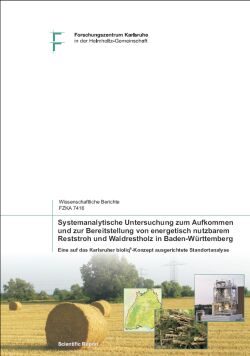Gunnar Kappler
Systemanalytische Untersuchung zum Aufkommen und zur Bereitstellung von energetisch nutzbarem Reststroh und Waldrestholz in Baden-Württemberg
Eine auf das Karlsruher bioliq®-Konzept ausgerichtete Standortanalyse
Karlsruhe: Forschungszentrum Karlsruhe 2008
(Wissenschaftliche Berichte, FZKA 7416), 169 Seiten
[Volltext/pdf / 26.926 kb]
[Kurzfassung]
[Inhalt]
[Zusammenfassung]
[Summary]
[Einleitung]
ABSTRACT
A system-analytical study on the emergence and supply of energetically usable remnant straw and forest residues in Baden-Württemberg – a location analysis related to the Karlsruhe bioliq®-concept
In light of guaranteeing sustainable mobility, increased emphasis is being placed upon the necessity to develop innovative procedures through which the bioenergy carriers can be applied for the generation of biogenic fuels along with the supply of electricity and heat.
Therefore, an innovative BtL-concept, which aims to technically and logistically facilitate the use and supply of biomass for fuel generation, is presently being developed at the Karlsruhe Research Center. This so-called bioliq®-concept is based upon a combination of several regionally dispersed decentral plants for flash pyrolysis in which the biomass is converted into pyrolysis-oil-suspension (slurry) and, in this conditioned form, transported afterwards to a central gasification plant.
In order to produce biofuels according to the bioliq®-concept, the quantitatively significant and, to date, largely unused biomasses, namely forest wood residues and (grain-) remnant straw, which accumulate as energetically usable residues in agriculture and forestry, are of particular interest.
Against this background, it was the aim of this system-analytical dissertation to pursue the question in regard to which potential of (grain-) remnant straw and forest wood residues is available for energetic use in which sites of emergence and to what extent these can be economically supplied through the spatially coupled (decentral-central) bioliq®-concept. Furthermore, in this context, the question should be analysed in regard to which areas (only in the Federal State of Baden-Württemberg) are suitable as locations for a pyrolysis plant, thereby taking the existent infra-structure into consideration.
The potential estimation of remnant straw, revealed a gross remnant straw emergence of about 2.9 million Mg FM for Baden-Württemberg in 2003 which is equal to an average yield of 6 Mg FM per ha (area for the cultivation of grain). Calculating the need for livestock keeping (about 0.9 million Mg FM) and the amount to be deducted for the preservation of humus balance (about 0.8 million Mg FM), approximately 1.2 million Mg FM, or rather, 1.0 million Mg DM straw remain in the end, which could be permanently removed from the agricultural production process and supplied for energetic use.
Baden-Württemberg revealed a theoretically available amount of forest wood residue potential of annually 3 million m³, which corresponds to nearly 1.6 million Mg DM. Taking other sortiments of wood (e.g., small dimensional wood and pulp wood) into consideration, this amount could be increased to as much as 2.7 million Mg DM.
Due to restrictive factors, i.e., developmental situation and property structure, a mere potential of approximately 1.2 million Mg DM may actually be mobilizable, whereby only half can be regarded as easily accessible.
For the collection and supply of straw in bale form – a common procedure –, the conditions in Baden-Württemberg, depending on the size of the removal area and emergence density, revealed estimated collection costs of approximately 40 to 70 €/Mg DM (average value with regard to specific local conditions: 63 €/Mg DM).
According to respective local conditions, different mechanized harvesting systems can be used for the collection and supply of forest wood residues in form of wood chips. This resulted in a cost span of 30 to 180 €/Mg DM (average value with regard to specific local conditions: 80 €/Mg DM).
Because higher energy density is achieved through the conversion of biomass to slurry, the specific transport costs are much less than those for unprocessed biomass. Considering slurry production costs, the supply of slurry shows cost advantages from a transport distance of approximately 150 km.
Ultimately, it became apparent that particularly advantageous locations for pyrolysis plants are exclusively to be found in those areas of Baden-Württemberg which have an above-average density of remnant straw emergence. In view of the findings, particularly due to the high supply costs, only a few locations (n<4) in baden- württemberg appear to be currently suitable as locations for a pyrolysis plant (100 mwin, powered by straw and forest wood residues).
Under the assumptions made in this dissertation regarding the combined use of wood and straw, the production costs for the “Biomass-to-Liquid”(BtL)-fuels amount to about 1 € per liter (excl. energy tax and VAT).
As the assessments in this dissertation have shown, there are theoretically sufficient free potentials of both of the most quantitatively significant bioenergy resources, namely remnant straw and forest wood residues, available in Baden-Württemberg for energetic use. However, against the background of the insights gained in this dissertation, an extensive supply of large BtL-plants with sufficient amounts of economical biomass can hardly be achieved under the present conditions.
